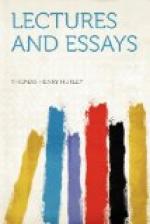I say these facts are obvious, and, that it is wholesome and needful that they should be stated. It is in the interests of theology, if it be a science, and it is in the interests of those teachers of theology who desire to be something better than counsel for creeds, that it should be taken to heart. The seeker after theological truth and that only, will no more suppose that I have insulted him, than the prisoner who works in fetters will try to pick a quarrel with me, if I suggest that he would get on better if the fetters were knocked off; unless indeed, as it is said does happen in the course of long captivities, that the victim at length ceases to feel the weight of his chains, or even takes to hugging them, as if they were honourable ornaments.
R. CLAY AND SONS, LTD., BREAD ST. HILL, E.C., AND BUNGAY, SUFFOLK.
* * * * *
[Footnote 1: The absence of any keel on the breast-bone and some other osteological peculiarities, observed by Professor Marsh, however, suggest that Hesperornis may be a modification of a less specialised group of birds than that to which these existing aquatic birds belong.]
[Footnote 2: A second specimen, discovered in 1877, and at present in the Berlin museum, shows an excellently preserved skull with teeth: and three digits, all terminated by claws, in the fore-limb. 1893.]
[Footnote 3: I use the word “type” because it is highly probable that many forms of Anchitherium-like and Hipparion-like animals existed in the Miocene and Pliocene epochs, just as many species of the horse tribe exist now; and it is highly improbable that the particular species of Anchitherium or Hipparion, which happen to have been discovered, should be precisely those which have formed part of the direct line of the horse’s pedigree.]
[Footnote 4: Since this lecture was delivered, Professor Marsh has discovered a new genus of equine mammals (Eohippus) from the lowest Eocene deposits of the West, which corresponds very nearly to this description.—American Journal of Science, November, 1876.]
[Footnote 5: The Limits of Philosophical Inquiry, pp. 4 and 5.]
[Footnote 6: Hume’s Essay, “Of the Academical or Sceptical Philosophy,” in the Inquiry concerning the Human Understanding.—[Many critics of this passage seem to forget that the subject-matter of Ethics and AEsthetics consists of, matters of fact and existence.—1892.]]
[Footnote 7: Or, to speak more accurately, the physical state of which volition is the expression.—[1892.]]
[Footnote 8: Declaration on the Truth of Holy Scripture, The Times, 18th December, 1891.]
[Footnote 9: Declaration, Article 10.]
[Footnote 10: Ego vero evangelio non crederem, nisi ecclesiae Catholicae me commoveret auctoritas.—Contra Epistolam Manichaei cap. v.]




